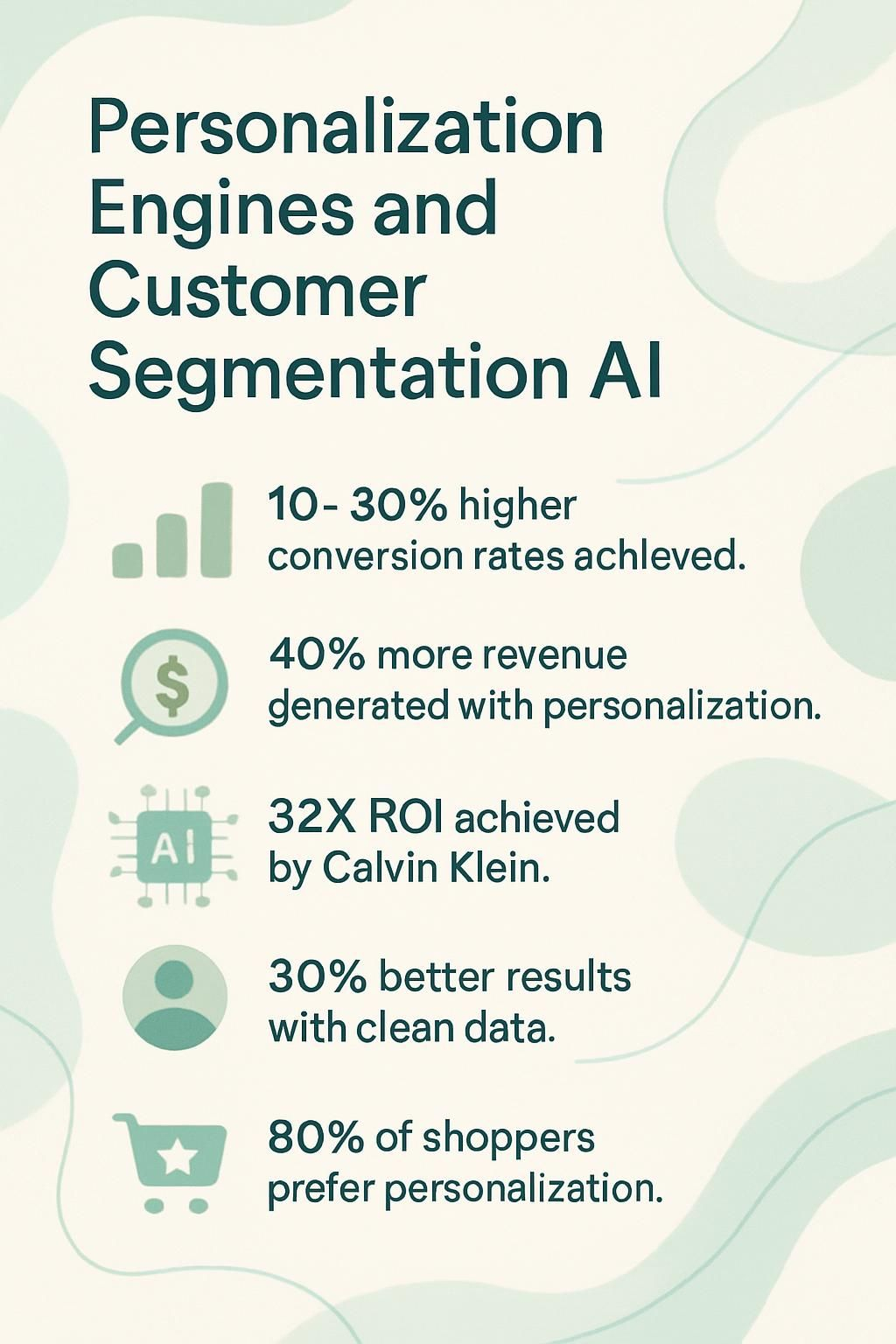Personalization Engines and Customer Segmentation AI


Understanding AI Integration

Personalization engines use artificial intelligence to customize what customers see based on their behavior and preferences. These intelligent systems collect data from websites, social media, and customer feedback to create tailored experiences in real-time.
Unlike traditional marketing that treats everyone the same, AI segmentation adapts as customer interests change. Reuben Smith, founder of WorkflowGuide.com, states, "Companies that excel at personalization make 40% more money than their competitors." This represents a trillion-dollar opportunity for American businesses.
The results speak for themselves. Calvin Klein saw a 32X return on investment with real-time personalization. Tesco's AI-powered Clubcard and Starbucks' Deep Brew system have turned casual shoppers into loyal fans.
Approximately 80% of customers prefer these personalized touches. Behind these success stories are technologies like machine learning, natural language processing, and predictive analytics working together to create individual customer journeys.
For business owners feeling uncertain about the technology, there's no need for concern. This article explains how these systems work, what distinguishes them from traditional marketing tools, and how you can implement them without needing a computer science degree.
The right AI tools complement your strategy - they enhance it. Let's explore how.
Key Takeaways
- AI-powered personalization engines track customer behavior in real-time across all platforms, delivering targeted content that boosts conversion rates by 10-30%.
- Companies using advanced personalization generate 40% more revenue than competitors by turning raw data into customized experiences that feel made for each customer.
- Calvin Klein achieved a 32X ROI through real-time personalization, while Starbucks increased loyalty with their Deep Brew platform that suggests drinks based on past orders.
- Effective implementation requires clean data flowing between systems—businesses with good data hygiene see 30% better results from their personalization efforts.
- About 80% of shoppers now prefer brands offering personalized interactions, making AI-driven customer segmentation essential for modern marketing success.

What Are Personalization Engines?

Personalization engines act as digital mind-readers that track, analyze, and respond to customer behavior across websites, apps, and stores. They crunch massive data sets to deliver the right message to the right person at exactly the right time—turning generic marketing into laser-focused conversations that feel almost spooky in their accuracy.
Definition and Core Functions
Personalization engines function as intelligent marketing tools that convert raw customer data into customized experiences. These systems gather, examine, and utilize user behavior patterns to tailor content, products, and messaging for each visitor.
At their core, these engines operate on predictive analytics algorithms that identify trends in how customers interact with your business. They don't merely guess what customers might like; they calculate it based on actual clicks, purchases, and browsing habits.
The process occurs in real-time as these systems adjust messaging across multiple channels automatically. Unlike basic marketing tools that send the same message to everyone, these engines modify offers based on individual preferences.
Consider them as digital predictors that anticipate a customer wants winter boots before they type it in the search bar. They draw from various data sources including zero-party data (information customers directly share) and first-party data (behavior on your platforms) to create those surprising moments that increase conversion rates.
Differences from Traditional Technologies
Now that we understand what personalization engines do, let's look at how they differ from older marketing tools. Traditional personalization systems rely on static rules and basic segmentation.
They group customers into broad categories based on limited data points like age, location, or past purchases. These systems often miss the mark because they treat people within the same group as identical twins when they're more like distant cousins.
AI-powered personalization engines break this mold completely. They process vast amounts of data in real-time, creating dynamic customer profiles that evolve with each interaction.
Unlike traditional systems that oversimplify customer complexity, AI adapts to changing preferences instantly. Machine learning algorithms spot patterns humans might miss, while predictive analytics anticipate needs before customers even express them.
This shift from reactive to proactive personalization creates a stark contrast. Think of traditional systems as a flip phone and AI personalization as the latest smartphone - both make calls, but one does so much more.
The difference between traditional and AI personalization is like comparing a paper map to GPS navigation - one shows you a fixed route, while the other adapts to traffic, detours, and your driving habits in real-time. - Reuben Smith
Role of AI in Customer Segmentation
AI transforms customer segmentation from static groups to living, breathing profiles that evolve with each click. Modern segmentation engines track behavior patterns across touchpoints and instantly adjust your marketing approach based on real-time signals.
AI-Powered Data Collection and Profiling
AI transforms data collection from a manual chore into a smart, automatic process. Modern systems gather info from multiple touchpoints like website clicks, purchase history, and social media interactions.
This tech doesn't just collect data; it makes sense of it by spotting patterns humans might miss. The magic happens when machine learning algorithms sort through millions of data points in seconds, creating detailed customer profiles that update in real time.
Gone are the days of static customer groups based on basic demographics. Today's AI tools track behavioral signals and predict future actions with surprising accuracy. They build rich profiles while respecting data privacy laws like GDPR and CCPA.
For business owners, this means you can finally understand what makes your customers tick without needing a data science degree. Your marketing becomes laser-focused because you know exactly who needs what, when they need it, and how they prefer to get it.
Dynamic Customer Segmentation in Real-Time
Building on data collection capabilities, real-time segmentation takes customer insights to the next level. AI engines now track and respond to customer actions as they happen, not days later when the opportunity has passed.
Gone are the days of static customer groups that grow stale within weeks.
Real-time segmentation adapts instantly to changing behaviors. A customer browsing winter coats might receive targeted offers within seconds, not after they've already made a purchase elsewhere.
Machine learning models continuously refine these segments based on fresh data points, creating fluid customer groupings that shift as interests evolve. This dynamic approach means businesses can spot emerging trends and pivot marketing efforts before competitors even notice the shift.
One retail client saw a 27% increase in conversion rates after implementing real-time segmentation that responded to browsing patterns within 30 seconds.
Real-time segmentation isn't just faster marketing, it's smarter marketing. It's the difference between showing up at a party with yesterday's conversation topics versus reading the room as you walk in. - Reuben Smith
Want To Be In The Inner AI Circle?
We deliver great actionable content in bite sized chunks to your email. No Flim Flam just great content.

Addressing Customer Pain Points with Personalization Engines
Personalization engines spot customer frustrations before they become deal-breakers. They transform generic shopping experiences into "this was made just for me" moments that keep customers coming back for more.
Creating Hyper-Personalized Customer Journeys
Customer journeys transform from generic to magical with AI-powered personalization engines. We map each touchpoint in your sales funnel and add personalized content exactly where it matters most.
The data shows this works: 80% of customers actively prefer brands offering personalized experiences. Your coffee shop regulars want their usual order ready, your HVAC clients expect reminders before seasonal changes, and your e-commerce shoppers crave product recommendations that feel intuitive.
One-size-fits-all marketing is outdated. Modern personalization connects your Customer Data Platform (CDP) with AI algorithms to create unique experiences. It's like having thousands of sales reps who remember every customer preference, past purchase, and browsing habit.
This approach doesn't just feel good, it drives results. My clients see higher engagement rates, longer customer lifespans, and better conversion rates across all channels. The key? Mapping the journey first, then applying personalization at critical decision points.
Enhancing Engagement Across Multiple Touchpoints
AI transforms how businesses connect with customers across all digital platforms. Your customers bounce between your website, mobile app, and social media accounts, often in a single day.
Without AI, these jumps create choppy experiences that feel like talking to different companies. AI fixes this by keeping track of what customers do and like, then serving up the right content at the right moment.
I've seen local HVAC companies boost their response rates by 40% just by making sure their text messages match their email tone.
The magic happens when your systems talk to each other. Picture a customer who browses air conditioners on your website in the morning, then opens your app that afternoon to find cooling options front and center.
That's not luck; it is smart AI working behind the scenes. These systems track behavior patterns and adjust in real time, so your marketing feels less like spam and more like helpful suggestions.
The data shows businesses using this approach see higher customer loyalty and better revenue growth. Your customers don't see separate channels, they see one business. Your tech should reflect that reality.
Benefits of AI-Powered Personalization Engines
AI-powered personalization engines boost revenue by 10-30% through spot-on product recommendations that match what customers actually want. These systems slash cart abandonment rates by creating shopping experiences that feel like they were built just for each person, turning casual browsers into loyal fans.
Improved Customer Retention and Loyalty
AI-driven personalization transforms casual shoppers into loyal fans through smart data use. Calvin Klein proved this with their jaw-dropping 32X ROI from real-time personalization efforts.
That's not pocket change! The magic happens when systems learn what customers want before they even know it. Tesco's Clubcard program builds emotional connections by offering deals that feel like they were made just for you.
No more generic "10% off everything" offers that miss the mark.
Starbucks knocked it out of the park with their Deep Brew platform, which tracks your coffee habits and suggests drinks you might love. This approach has grown their active rewards members substantially.
The coffee giant figured out that loyalty comes from feeling understood. Your business can create the same sticky customer relationships by serving up relevant offers at perfect moments.
The data shows customers stick around longer when they receive personalized rewards that match their actual needs. Smart personalization isn't just a tech gimmick, it is a retention strategy with real dollars behind it.
Increased Conversions and Revenue
Beyond just retaining customers for longer periods, personalization engines directly increase your revenue. Companies that excel at personalization generate 40% more revenue than their average competitors.
That's a significant difference! The logic is straightforward: when customers encounter products and offers that align with their needs, they make more purchases.
AI-powered personalization converts browsers into buyers by presenting the appropriate message at the optimal time. This targeted approach reduces waste in your marketing budget while increasing conversion rates.
The potential impact is substantial, with studies indicating that personalization could create over $1 trillion in added value across U.S. industries. For local business owners, this means your limited marketing resources are utilized more effectively and efficiently, driving genuine growth instead of simply creating noise in the marketplace.
Implementing Personalization Engines for Your Business
Implementing personalization engines doesn't require a computer science degree - just clean data and clear goals. Start with a basic integration that pulls from your existing customer database, then gradually expand your AI-driven campaigns as you measure what actually works for your specific audience.
Integrating Customer Data Seamlessly
Data silos kill personalization faster than a game character with no health potions. I've seen businesses collect mountains of customer information across different platforms, only to have it sit in separate systems that don't talk to each other.
The magic happens when you connect these islands of data. Your CRM needs to shake hands with your email platform, website analytics, and social media insights. This unified view helps AI personalization engines spot patterns humans might miss, like that customer who browses winter products in July (planning ahead or living in Australia?).
Quality data beats quantity every time. Garbage in, garbage out applies perfectly here. Before feeding information into your personalization engine, clean it up. Remove duplicates, fix formatting issues, and verify accuracy.
At WorkflowGuide.com, we've found that businesses who prioritize data hygiene see 30% better results from their personalization efforts. Cross-team collaboration makes this process smoother too.
Get your marketing folks talking with IT and sales teams to create a shared understanding of how customer data flows through your business. This teamwork approach breaks down walls and builds bridges to better customer experiences.
Setting Up AI-Driven Personalization Campaigns
Starting an AI-driven personalization campaign requires clear goals and clean data. First, map your customer journey to spot key touchpoints where personalization matters most. Your data needs to flow between systems without getting stuck in silos, a common headache I've seen kill great campaigns before they start.
Think of it like building a gaming character; each data point adds to the profile until you can predict the next move.
Testing is non-negotiable for these campaigns. Launch small experiments, measure results, and scale what works. Many business owners jump straight to full deployment and crash like my first coding project in college (still haunts me).
Privacy concerns also demand attention, with proper consent mechanisms built into your data collection. The payoff speaks for itself: businesses using AI personalization see conversion rates climb by 10-30% and customer retention improve significantly.
Just avoid the "creepy factor" by personalizing thoughtfully rather than showing customers you know their entire search history.
Integrating AI into Your Content Marketing Strategy
AI transforms your content marketing from generic to genius. I've seen businesses boost revenue by 5-15% just by letting smart algorithms analyze customer data and craft personalized messages.
Your content stops being a shot in the dark and becomes a heat-seeking missile that finds exactly what each customer wants. Machine learning doesn't just segment audiences; it predicts what they'll need next before they even know it themselves.
Gone are the days of blasting the same blog post to everyone. With AI-powered tools, your content adapts automatically based on user behavior. A local HVAC company I worked with used predictive analytics to serve different content to homeowners versus property managers, increasing engagement by 38%.
The system learned which pain points mattered to each group and adjusted messaging accordingly. The best part? This happens in real-time while you focus on creating quality content instead of guessing what might stick.
Conclusion
Personalization engines have transformed how businesses connect with customers through intelligent data use. These AI systems exceed basic targeting by creating customized experiences that address individual needs and behaviors directly.
Your business can improve retention rates, increase sales, and strengthen customer relationships by implementing these tools strategically. The effectiveness emerges when you combine quality data collection with machine learning algorithms that continuously refine your segmentation approach.
Start by auditing your current customer data and identifying opportunities for more personalized interactions. Your customers will notice the difference, and your bottom line will benefit from adopting this technology that makes marketing feel less like marketing and more like helpful service.
FAQs
1. What are personalization engines in marketing?
Personalization engines use AI to tailor content to individual customers. They analyze shopping habits, clicks, and past purchases to show people what they'll likely want. Think of them as digital mind readers that turn random shoppers into loyal fans.
2. How does customer segmentation AI work?
Customer segmentation AI groups people based on shared traits and behaviors. It sifts through mountains of data to spot patterns humans might miss. The system then creates distinct customer buckets, helping businesses target their messages more effectively.
3. What benefits do personalization engines offer to businesses?
They boost sales by showing customers exactly what they want. Personalization also cuts marketing waste since you're not showing irrelevant ads to people who don't care. Plus, customers stick around longer when they feel understood.
4. Can small businesses use personalization AI too?
Absolutely! Many affordable tools now exist for businesses of all sizes. Small shops can start with basic segmentation and grow their tech as they expand. The playing field has leveled, letting the little guys compete with big brands for customer attention.
Additional Insights and Considerations
Data Privacy & Security Considerations
AI-driven personalization engines rely on the secure processing of consumer data. Organizations must comply with regulations like GDPR and CCPA while implementing strong data analytics and cleaning protocols. Secure handling of data enhances the user experience and protects consumer insights.
Methodology Transparency
This content presents data analytics and consumer behavior examples based on internal assessments and external industry research. Clear documentation of data analysis and behavioral tracking methods authenticates the figures and claims presented. These practices reinforce the credibility of the targeted marketing strategies discussed.
Still Confused
Let's Talk for 30 Minutes
Book a no sales only answers session with a Workflow Guide
References and Citations
Disclosure: This content is informational and solely for educational purposes. WorkflowGuide.com stands by transparency. No sponsorship or affiliate relationships affect the content's viewpoint. The data and examples come from public sources and internal case studies.
References
- https://www.braze.com/resources/articles/a-complete-guide-to-personalization-engines (2025-05-29)
- https://nacelle.com/blog/what-is-a-personalization-engine-definition-components-modern-capabilities
- https://www.byteplus.com/en/topic/381927
- https://digitaltrek.ca/ai-and-customer-segmentation/ (2024-02-18)
- https://www.meegle.com/en_us/topics/ai-driven-personalization/ai-powered-personalized-customer-segmentation
- https://abmatic.ai/blog/how-ai-transforms-customer-segmentation-in-personalized-marketing
- https://www.linkedin.com/pulse/creating-hyper-personalized-customer-journeys-ai-big-data-terrene-xna4c
- https://www.ibm.com/think/topics/hyper-personalization
- https://www.meegle.com/en_us/topics/ai-driven-personalization/ai-for-personalized-customer-experience-strategies
- https://www.cprime.com/resources/blog/enhancing-customer-loyalty-with-ai-powered-personalization/
- https://ermarketing.net/navigate-the-channel/ai-powered-personalization-in-marketing-enhancing-customer-experiences/
- https://www.researchgate.net/publication/388190363_The_Effects_of_AI-Powered_Personalization_on_Consumer_Behavior_in_Fashion_E-Commerce
- https://www.meegle.com/en_us/topics/ai-driven-personalization/ai-powered-personalization-engines
- https://marketing.expertjournals.com/ark:/16759/EJM_1206vinerean70-79.pdf



